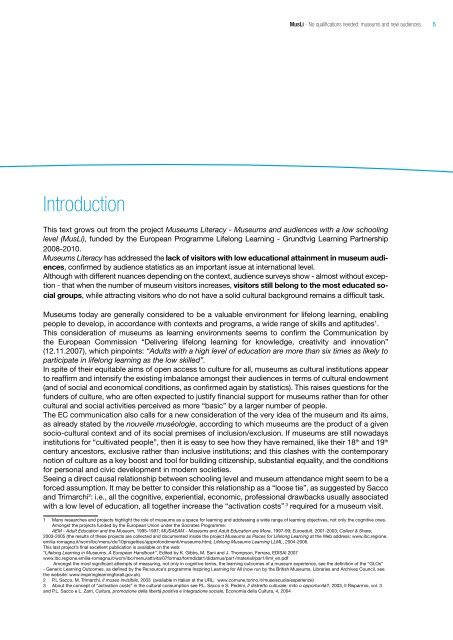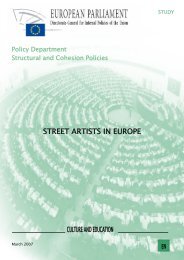MusLi (Museums Literacy) - Fondazione Fitzcarraldo
MusLi (Museums Literacy) - Fondazione Fitzcarraldo
MusLi (Museums Literacy) - Fondazione Fitzcarraldo
Create successful ePaper yourself
Turn your PDF publications into a flip-book with our unique Google optimized e-Paper software.
Introduction<br />
<strong>MusLi</strong> - No qualifications needed: museums and new audiences<br />
This text grows out from the project <strong>Museums</strong> <strong>Literacy</strong> - <strong>Museums</strong> and audiences with a low schooling<br />
level (<strong>MusLi</strong>), funded by the European Programme Lifelong Learning - Grundtvig Learning Partnership<br />
2008-2010.<br />
<strong>Museums</strong> <strong>Literacy</strong> has addressed the lack of visitors with low educational attainment in museum audiences,<br />
confirmed by audience statistics as an important issue at international level.<br />
Although with different nuances depending on the context, audience surveys show - almost without exception<br />
- that when the number of museum visitors increases, visitors still belong to the most educated social<br />
groups, while attracting visitors who do not have a solid cultural background remains a difficult task.<br />
<strong>Museums</strong> today are generally considered to be a valuable environment for lifelong learning, enabling<br />
people to develop, in accordance with contexts and programs, a wide range of skills and aptitudes 1 .<br />
This consideration of museums as learning environments seems to confirm the Communication by<br />
the European Commission “Delivering lifelong learning for knowledge, creativity and innovation”<br />
(12.11.2007), which pinpoints: “Adults with a high level of education are more than six times as likely to<br />
participate in lifelong learning as the low skilled”.<br />
In spite of their equitable aims of open access to culture for all, museums as cultural institutions appear<br />
to reaffirm and intensify the existing imbalance amongst their audiences in terms of cultural endowment<br />
(and of social and economical conditions, as confirmed again by statistics). This raises questions for the<br />
funders of culture, who are often expected to justify financial support for museums rather than for other<br />
cultural and social activities perceived as more “basic” by a larger number of people.<br />
The EC communication also calls for a new consideration of the very idea of the museum and its aims,<br />
as already stated by the nouvelle muséologie, according to which museums are the product of a given<br />
socio-cultural context and of its social premises of inclusion/exclusion. If museums are still nowadays<br />
institutions for “cultivated people”, then it is easy to see how they have remained, like their 18 th and 19 th<br />
century ancestors, exclusive rather than inclusive institutions; and this clashes with the contemporary<br />
notion of culture as a key boost and tool for building citizenship, substantial equality, and the conditions<br />
for personal and civic development in modern societies.<br />
Seeing a direct causal relationship between schooling level and museum attendance might seem to be a<br />
forced assumption. It may be better to consider this relationship as a “loose tie”, as suggested by Sacco<br />
and Trimarchi 2 : i.e., all the cognitive, experiential, economic, professional drawbacks usually associated<br />
with a low level of education, all together increase the “activation costs” 3 required for a museum visit.<br />
1 Many researches and projects highlight the role of museums as a space for learning and addressing a wide range of learning objectives, not only the cognitive ones.<br />
Amongst the projects funded by the European Union under the Socrates Programme:<br />
AEM - Adult Education and the Museum, 1995-1997; MUSAEAM - <strong>Museums</strong> and Adult Education are More, 1997-99; Euroedult, 2001-2003; Collect & Share,<br />
2003-2005 (the results of these projects are collected and documented inside the project <strong>Museums</strong> as Places for Lifelong Learning at the Web address: www.ibc.regione.<br />
emilia-romagna.it/wcm/ibc/menu/dx/10progettieu/approfondimenti/museums.htm); Lifelong <strong>Museums</strong> Learning LLML, 2004-2006.<br />
This last project’s final excellent publication is available on the web:<br />
“Lifelong Learning in <strong>Museums</strong>. A European Handbook”, Edited by K. Gibbs, M. Sani and J. Thompson, Ferrara, EDISAI 2007<br />
www.ibc.regione.emilia-romagna.it/wcm/ibc/menu/attivita/07formaz/formdidat1/didamus/par1/materiali/par1/llml_en.pdf<br />
Amongst the most significant attempts of measuring, not only in cognitive terms, the learning outcomes of a museum experience, see the definition of the “GLOs”<br />
- Generic Learning Outcomes, as defined by the Re:source’s programme Inspiring Learning for All (now run by the British <strong>Museums</strong>, Libraries and Archives Council, see<br />
the website: www.inspiringlearningforall.gov.uk).<br />
2 P.L Sacco, M. Trimarchi, Il museo invisibile, 2003 (available in Italian at the URL: www.comune.torino.it/museiscuola/esperienze)<br />
3 About the concept of “activation costs” in the cultural consumption see P.L. Sacco e S. Pedrini, Il distretto culturale: mito o opportunità?, 2003, Il Risparmio, vol. 3<br />
and P.L. Sacco e L. Zarri, Cultura, promozione della libertà positiva e integrazione sociale, Economia della Cultura, 4, 2004<br />
5






